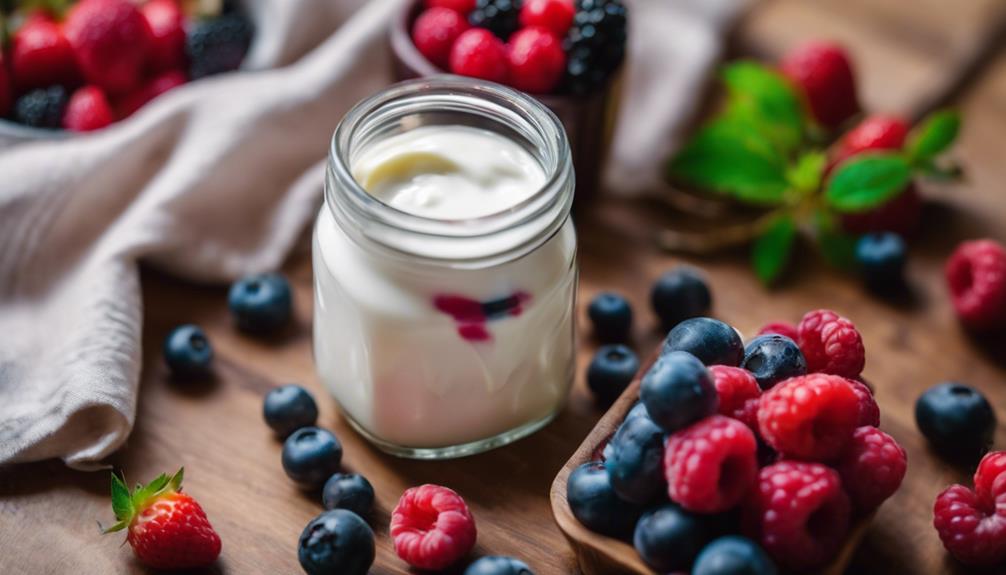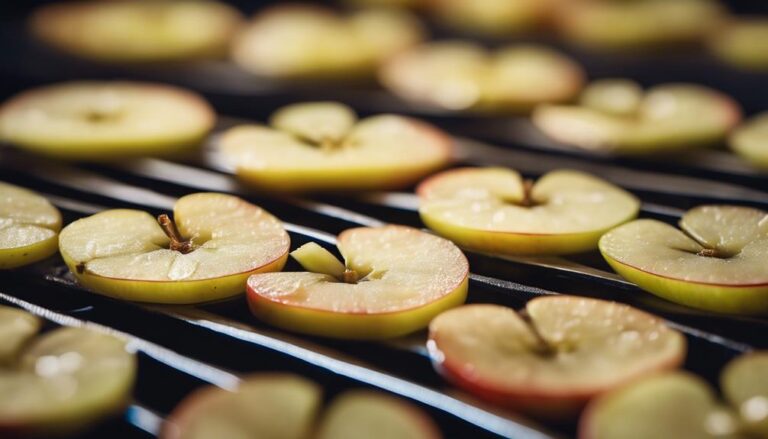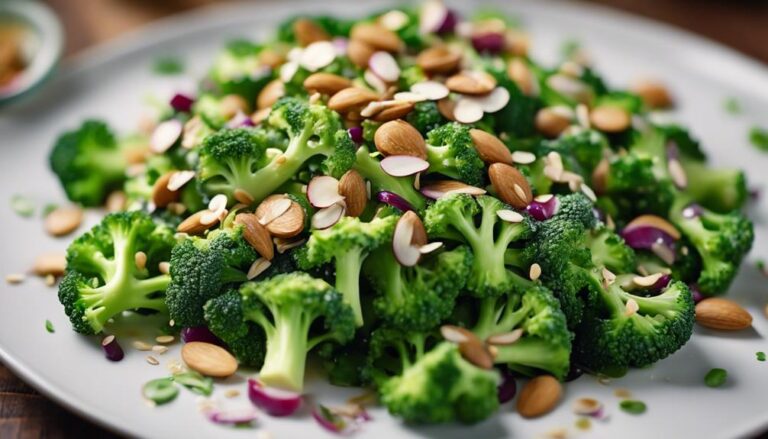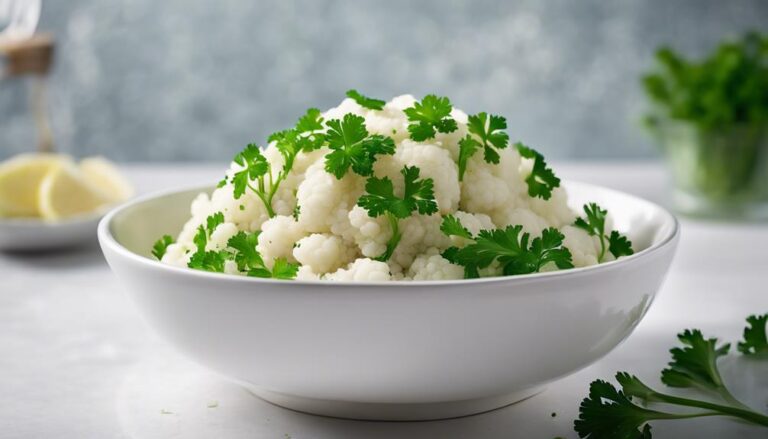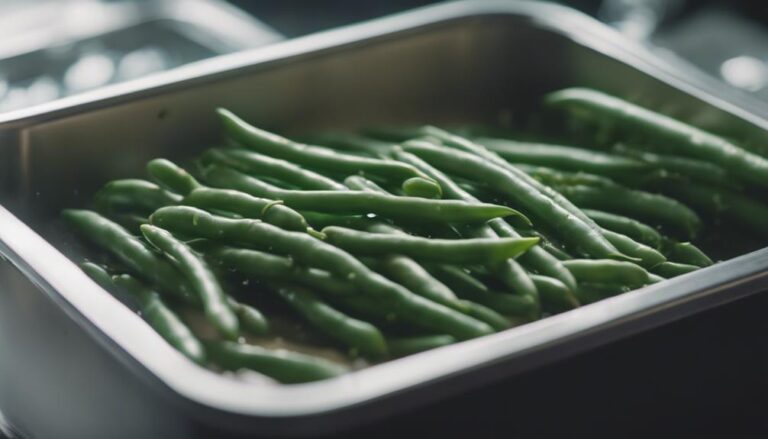Sous Vide Homemade Yogurt With Fresh Berries
Create velvety homemade yogurt by utilizing the exact sous vide method. Pair it with vibrant, handpicked berries for an unparalleled burst of flavor. Elevate your meal or snack to a whole new level by blending creamy yogurt with fresh fruit. The combination will tantalize your taste buds.
What You Will Learn Here
- Sous vide technique ensures precise yogurt incubation temperature.
- Fresh berries add flavor and nutritional value to homemade yogurt.
- Experiment with different berry combinations for varied taste profiles.
- Use starter culture for desired yogurt tanginess and consistency.
- Yogurt's probiotics combined with berries offer a nutritious snack option.
Yogurt-Making Origins
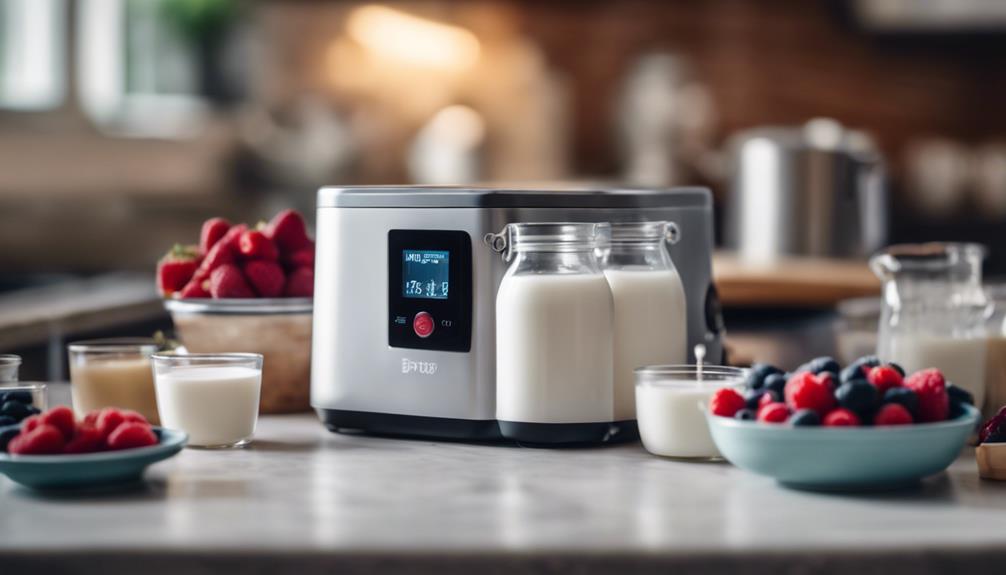
Yogurt's historical roots trace back to ancient civilizations like the Mesopotamians and the Greeks, who harnessed the natural process of milk fermentation. Traditional yogurt cultures played a significant role in shaping the diverse range of flavors and textures found in yogurts around the world.
With modern techniques like sous vide, yogurt-making has evolved to offer precise control over temperature and time, resulting in consistent and delicious homemade yogurts.
Yogurt's Historical Roots
With origins dating back thousands of years, the process of making yogurt traces back to ancient civilizations. Ancient practices of fermenting milk to create yogurt have been found in various cultures, showcasing the early recognition of its nutritional value and longer shelf life. Historically, yogurt held significant cultural importance, with ancient societies like the Greeks, Romans, and Indian civilizations incorporating it into their diets and religious practices.
The art of yogurt-making evolved over time, adapting to different regions and climates. This early form of food preservation not only provided sustenance but also contributed to the development of diverse culinary traditions. Understanding yogurt's historical roots sheds light on its enduring legacy as a versatile and nutritious food staple.
Traditional Yogurt Cultures
Traditional cultures across different regions have long embraced the practice of fermenting milk to create yogurt, showcasing a rich history of culinary innovation rooted in ancient traditions.
These traditional practices involve the fermentation process, where specific strains of bacteria, such as Lactobacillus bulgaricus and Streptococcus thermophilus, are used to culture the milk. The fermentation process transforms the milk sugars into lactic acid, giving yogurt its characteristic tangy flavor and creamy texture.
Each culture has its unique way of preparing and fermenting yogurt, often passed down through generations, adding a cultural significance to the final product. Understanding the traditional methods behind yogurt-making not only provides insight into its origins but also highlights the diverse approaches to this ancient culinary art.
Modern Yogurt Techniques
Exploring the evolution of yogurt-making techniques reveals a fascinating journey of innovation and adaptation in the domain of dairy fermentation. Modern yogurt techniques have seen a significant shift towards precision and control, with the introduction of sous vide techniques to regulate the fermentation process.
Homemade yogurt enthusiasts now have the opportunity to experiment with flavors and textures like never before, thanks to these advancements. The sous vide method allows for consistent temperature maintenance, ensuring a more reliable fermentation process and yielding a deliciously creamy end product.
This innovative approach to yogurt-making has opened up a world of possibilities for flavor customization and texture manipulation, empowering home cooks to create artisanal yogurts tailored to their preferences.
Key Yogurt Components
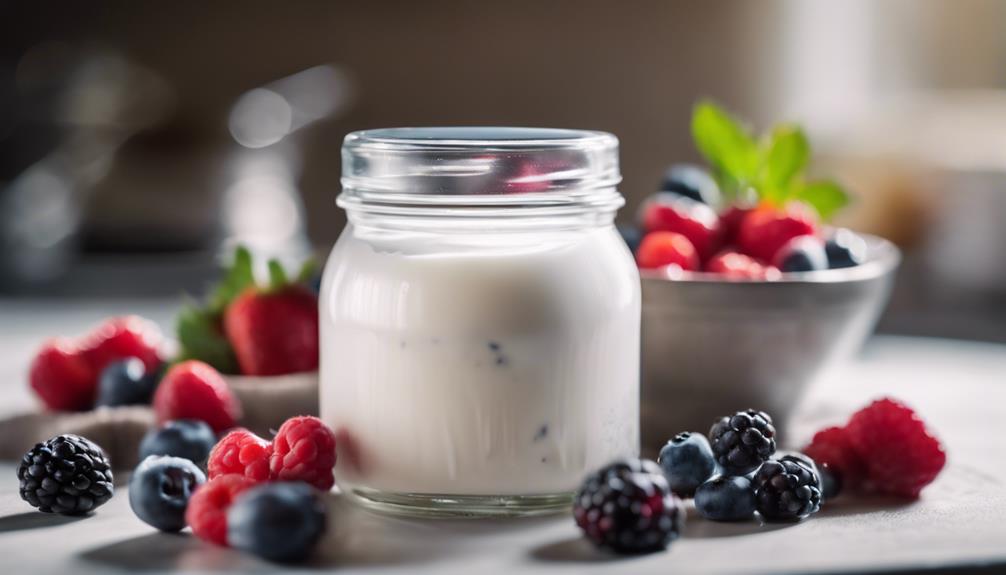
To enhance the nutritional value and texture of your homemade yogurt, understanding the key components involved is vital. Here are the essential elements that contribute to the quality and health benefits of your yogurt:
- Probiotic Benefits: The live cultures present in yogurt are a result of the fermentation process. These probiotics are beneficial bacteria that support gut health, aid digestion, and boost the immune system.
- Nutritional Value: Yogurt is rich in essential nutrients like calcium, protein, vitamin B12, and potassium. These components contribute to bone health, muscle function, and overall well-being.
- Milk: The base ingredient for yogurt, milk provides the proteins and sugars necessary for the fermentation process. Different types of milk can alter the final texture and flavor of the yogurt.
- Starter Culture: This is the source of live bacteria that kickstart the fermentation process. Choosing the right starter culture can influence the tanginess and consistency of your yogurt.
Understanding and balancing these components will help you create a delicious and nutritious batch of homemade yogurt.
Yogurt-Making Variations
You can experiment with different yogurt-making variations to add variety to your homemade yogurt.
Try making a creamy Greek yogurt for a thicker and tangier option, or opt for a berry-infused recipe for a fruity twist.
For a nutritious boost, consider blending chia seeds into your yogurt for added texture and health benefits.
Creamy Greek Yogurt Recipe
For consistently creamy Greek yogurt, keep in mind four key factors when making a delicious batch of creamy Greek yogurt:
- Temperature Control: Utilize a reliable thermometer to monitor and regulate the temperature accurately throughout the incubation period.
- Straining Method: Opt for a longer straining time to achieve that thick and creamy consistency characteristic of Greek yogurt.
- Milk Selection: Use whole milk for a richer texture or experiment with different fat contents to find the perfect balance between creaminess and flavor.
- Starter Culture: Choose a high-quality starter culture specifically designed for Greek yogurt to enhance the tanginess and creaminess of the final product.
Berry-Infused Yogurt Recipe
Enhance your homemade yogurt with a burst of fresh berries for a delightful twist on this classic treat. Adding berry swirls to your yogurt can elevate its flavor profile to tangy perfection and bring a pop of color to your dish.
Here are some ways to achieve a creamy texture with a fruit infusion:
- Gently fold in a mix of mashed berries into your yogurt for a fruity explosion in every spoonful.
- Experiment with different berry combinations like strawberries and blueberries for a dynamic flavor experience.
- Layer your yogurt with whole berries to add a burst of freshness and texture.
- Use a high-quality berry compote to drizzle over your yogurt for a decadent touch of sweetness.
Chia Seed Yogurt Blend
To create a unique twist on homemade yogurt, consider incorporating chia seeds for added texture and nutritional benefits. Chia seeds are packed with fiber, omega-3 fatty acids, and antioxidants, making them a great addition to your yogurt blend.
Here are some ways to elevate your chia seed yogurt:
- Chia Seed Benefits: Boost the nutritional profile of your yogurt with chia seeds known for their health benefits.
- Yogurt Texture: Chia seeds add a delightful crunch and gel-like texture to your yogurt, enhancing the overall mouthfeel.
- Flavor Pairings: Experiment with different flavor combinations like honey and cinnamon or fresh fruit to complement the nutty taste of chia seeds.
- Chia Seed Pudding: Mix yogurt with chia seeds and let it sit overnight for a delicious chia seed pudding breakfast option.
Yogurt-Setting Temperature Guidelines
When making yogurt, the temperature at which you set your yogurt is essential for achieving the desired consistency and flavor. Different temperatures can impact how long it takes for the yogurt to set, influencing the overall quality of the final product.
Factors such as the type of milk used, the starter culture, and the incubation time also play a role in determining the ideal temperature for setting yogurt.
Optimal Temp for Yogurt
Maintaining the vital temperature during the yogurt-making process is essential for achieving the desired consistency and flavor profile in your homemade yogurt. Temperature plays a pivotal role in the yogurt-setting process, impacting both texture and taste.
Ideal temperatures for yogurt setting typically range between 110°F to 115°F (43°C to 46°C), as these temperature variations promote the growth of beneficial bacteria, leading to a creamy and smooth consistency. Consistently maintaining this temperature range throughout the incubation period guarantees a successful yogurt outcome.
Lower temperatures may result in a thinner consistency, while higher temperatures can lead to a grainy texture. By paying close attention to the temperature during the yogurt-making process, you can elevate the quality of your homemade yogurt to new heights.
Time for Yogurt Setting
For ideal yogurt setting, ensuring appropriate incubation time is essential to achieve the desired consistency and flavor profile. Yogurt consistency is largely dependent on the fermentation process during incubation. The longer the incubation time, the thicker and tangier the yogurt becomes due to increased fermentation.
The texture of yogurt is also impacted by the incubation period. A longer incubation time typically results in a firmer and creamier texture, while a shorter period may yield a thinner and more liquid consistency. It's important to monitor the incubation time carefully to achieve the desired yogurt texture.
Experimenting with different incubation durations can help you tailor the yogurt to your preferences, whether you prefer a thicker Greek-style yogurt or a smoother, milder version.
Factors Affecting Yogurt-Making
To optimize the quality of your homemade yogurt, precise monitoring of the temperature during the yogurt-setting process is essential for achieving the desired consistency and flavor profile. Temperature fluctuations can greatly impact the final product. Maintaining a consistent temperature, usually between 110°F to 115°F, is vital for the starter cultures to properly ferment the milk. Different milk types may require slight variations in temperature for best results. Additionally, the length of the incubation time can also influence the texture and tanginess of the yogurt. Properly balancing these factors will help you create a delicious and creamy yogurt that suits your preferences. Below is a table summarizing the key aspects to take into account when setting the yogurt temperature:
| Factors | Guidelines | Importance |
|---|---|---|
| Temperature | 110°F to 115°F | Starter Cultures |
| Milk Types | Cow's Milk, Goat's Milk, Almond Milk, etc. | Flavor Variations |
| Incubation Time | 4 to 8 hours | Texture Development |
Final Thoughts
Consider incorporating a variety of fresh berries to enhance the flavor profile and nutritional value of your sous vide homemade yogurt. The addition of berries not only introduces vibrant colors and textures but also boosts the antioxidant content of your dish. Experiment with different flavor combinations such as blueberries and raspberries for a sweet-tart balance or strawberries and blackberries for a more mellow taste. These berries not only provide a burst of flavor but also contribute essential vitamins, minerals, and dietary fiber, further elevating the health benefits of your yogurt.
When serving your sous vide homemade yogurt with fresh berries, consider layering them in a glass for a visually appealing presentation or topping the yogurt with a generous amount of mixed berries for a delightful contrast in every spoonful. Not only does this enhance the overall sensory experience, but it also adds a variety of textures to each bite. Additionally, the combination of yogurt's probiotic strains and the nutrients present in fresh berries makes for a well-rounded and nutritious snack or breakfast option. Experiment with different berries and presentation styles to find your favorite combination that suits your taste preferences and nutritional needs.
Frequently Asked Questions
Can Different Types of Milk Be Used to Make Yogurt?
Yes, different types of milk alternatives can be used to make yogurt by introducing yogurt cultures. Almond, coconut, and soy milk are common alternatives. These milks may require adjustments in consistency and flavor compared to traditional dairy milk.
How Long Can Homemade Yogurt Be Stored in the Fridge?
To maintain freshness, store homemade yogurt in the fridge for up to two weeks. Proper storage guarantees a longer shelf life for your yogurt. Refrigeration is key to preserving the quality of homemade yogurt.
Is It Necessary to Use a Sous Vide Machine for Yogurt-Making?
You don't need a sous vide machine for yogurt-making. Alternative methods like using an oven with temperature control work well. Equipment options vary from yogurt makers to simple jars. Experiment with different methods for flavor variations.
Can Yogurt Be Made Without the Addition of Sweeteners?
Yes, yogurt can be made without sweeteners. By allowing the natural yogurt flavors to shine, you preserve the health benefits of this nutritious food. Avoiding sweeteners can help maintain a healthier diet and enhance the yogurt's inherent goodness.
What Are Some Creative Ways to Incorporate Homemade Yogurt Into Recipes?
Experiment with flavor combinations like honey and pistachios or savory options with herbs and olive oil. Utilize cooking techniques such as marinating proteins in yogurt for tenderness or incorporating it into baked goods for added moisture and tang.
Conclusion
In summary, making homemade yogurt using the sous vide method offers a precise and controlled environment for ideal fermentation.
By understanding the key components and variations in yogurt-making, you can experiment with different flavors and textures.
Setting the yogurt at the right temperature is essential for achieving the desired consistency.
With fresh berries as a topping, you can enjoy a delicious and nutritious treat that's both satisfying and healthy.
Bon appétit!
